
| Ferndale | |
| The name Ferndale is a direct Anglicisation of the Welsh name Glyn Rhedynog and was first adopted in the 1860's, by either David Davies, Blaengwawr who sank the Ferndale pits or his chief cashier Delta Davies. The 1847 tithe map for Ferndale shows a large expanse of woods, meadows and fields, with the only human intrusion being the two farms of Rhondda- Fechan, farmed by David Evans, and Dyffryn Sarfwch, farmed by William Davies. Whilst across the valley Blaenllechau were the isolated farmsteads of Blaenllechau, Pendyrys Isaf and Pen-Yr-Heol. | |
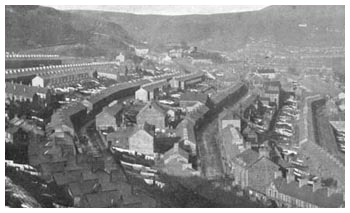 |
The pioneer of the coal industry in this part of the Rhondda Fach was David Davis (1797-1866) who had gained his wealth firstly as a tradesman with shops in Hiwaun and Aberdare and later as the owner of steam coal companies in Blaengwawr(Aberdare) and Abercwmboi. He encountered numerous difficulties in his attempts to mine the area around Ferndale. His first attempt to reach the No.3 Rhondda seam were unsuccessful and the isolated nature of Ferndale at that time meant that all the machinery and materials for the enterprise had to be conveyed from the Aberdare valley by horses, the mountain track being too narrow for carts. |
| It was when Lewis Davis, David's son recommended sinking the pit to a much greater depth that the Four Feet seam was eventually struck at a depth of 278 yards in 1862. The quality of the seam was found to be much greater than that found in the Aberdare Valley and subsequently the No.1 pit was also deepened to two equally important new seams. Meanwhile the Taff Vale Railway had extended its operations from Ynyshir to Blaenllechau, enabling in 1862 the first load of steam coal to be sent from Ferndale to Cardiff. Thus the industrial age in the Rhondda Fach had truly begun. | 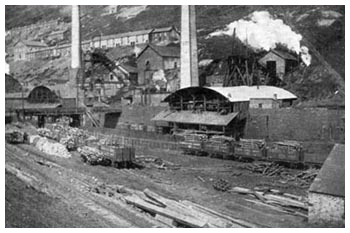 |
| In common with most areas of the Rhondda upon the discovery of coal and the influx of workers, accommodation quickly became a problem. The original sinkers of the pits (about 40 in number) had been lodged in one dwelling house, ‘Y Lluest'. Whilst the first miners and their families, lured to Ferndale through adverts in the South Wales press for ‘work under good conditions', were housed in a large number of wooden huts known as ‘The barracks'. In 1867 a reporter from the ‘Times' who visited Ferndale described how "…almost all the population of 800 is lodged in houses rudely built of wood, like American log huts". It was not until into the 1870's when much larger numbers migrated into the district that the huts were taken down and the colliery company built the familiar long terraces of stone houses to house this expanding population. |
|
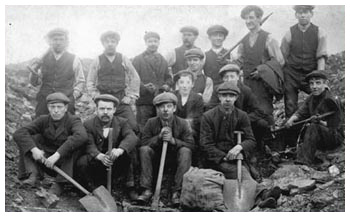 |
Ferndale like many of the towns of the Rhondda suffered through the dangerous nature of the mining industry, particularly in its early days. As well as numerous deaths through falls of rocks, dram accidents and other similar incidents it also suffered two major disasters in its early days. One in 1867 where 178 men and boys were killed, and one only two years later in 1869 when 53 miners lost their lives. Left: Striker looking for coal on the tips during the 1921 strike |
| Ferndale quickly became the main township of the Rhondda Fach with a busy shopping centre, based around The Strand, as well as The Ferndale Workmen's General Hospital and Eye Infirmary, built in 1891. It also boasted numerous chapels such as Trerhondda built in 1867, the Wesleyan Methodist Chapel, built in 1880 and subsequently rebuilt after a fire in 1893 by family, friends and colleagues of the late Lewis Davis, the coal owner, as a tribute to his memory. It also boasted numerous recreation facilities with Darran Park and lake, an outdoor swimming pool as well as the ever present Workmen's Institute and Library. | |
| FERNDALE COLLIERY DISASTERS -THE TRUE PRICE OF COAL | |
| In 1988 adjacent to where Ferndale No.1 and No.5 pits once stood a memorial was erected commemorating, ‘those miners who worked, or were killed or injured in the four Ferndale pits. Including the 231 miners who lost their lives in two frightful explosions at No.1 pit in 1867 and 1869'. The Ferndale concerns were the property of D.Davies and Sons, and prospered in the 1860's, however with the death of Davis snr. in 1866 followed by the two explosions of 1867 and 1869 the enterprise at Ferndale started to founder. The disasters, in 1867 when 178 miners were killed and 1869 when the death toll was 53 gave Ferndale a reputation as a ‘bad place' where ‘the shadow of death seemed to rest over the valley'. In fact more miners died at Ferndale No.1 pit than in any other coal mine in the Rhondda. As a consequence many of the miners started to drift away from Ferndale to find work elsewhere and Lewis Davis, the then owner, found it expedient to move to Ferndale (where he built Brynderwen House) to personally supervise the operations there. Thankfully no other major disasters occurred at Ferndale, but the memory of the disasters of 1867 and 1869 left a scar that took many years to heal in this part of the Rhondda Fach. However the everyday dangers of the mining industry can be shown by this list of fatal accidents at Ferndale Colliery from 1896. As you can see in this one year alone thirteen men died underground in separate accidents, a toll that would be echoed throughout the mines of the Rhondda at that time. |
|
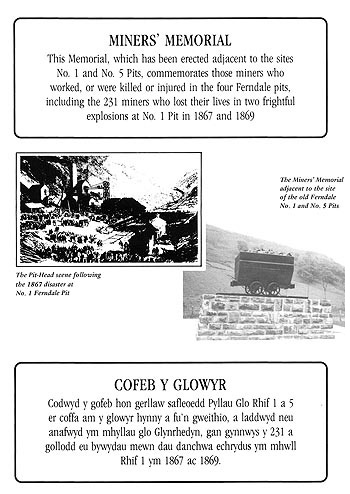 |
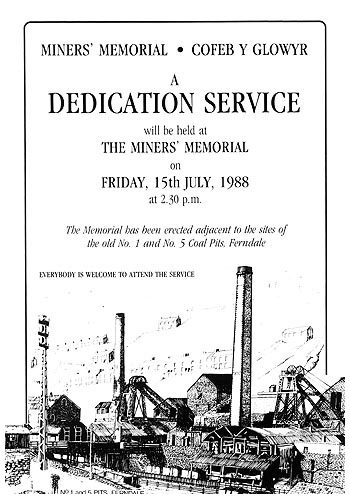 |
‘FATAL FRIDAY AT FERNDALE' THE FERNDALE NO.1 PIT COLLIERY EXPLOSION 8TH NOVEMBER 1867 |
|
| The Merthyr Express newspaper of the time reports the ‘tidings of one of the most calamitous explosions in South Wales' (in fact the Surveyor of Mines report into the explosion states it as being the largest ever number killed in one explosion in his district at that time). The newspaper goes on to describe the aftermath of the explosion, the tides of sympathy felt for the victims and their families from ‘throughout the land', and the scenes at the pit-head where crowds had gathered to identify loved ones, and the daily procession of bodies brought up from the mine. The true scale of the tragedy in a small village such as Ferndale where nearly every working man and boy were employed in the same pit is illustrated by the mention of one victim Thomas Thomas who died in the disaster along with his four sons. The reporter also describes the grief of one girl who had ‘followed one brother to the grave on Wednesday, another on Thursday, and her father and third brother are still undiscovered in the pit'. The report of the Mines Inspectors into the disaster presented at the inquest into its victims states: | |
‘We believe the explosion took place, first - in consequence of a great accumulation of gas in certain workings of the colliery, and this accumulation we attribute to the neglect of Mr. Williams the manager and his subordinate officers, second - by this gas being fired by one or more of the colliers carelessly taking off the tops of their lamps and working with naked lights.' After the explosion a Disaster fund was set up to alleviate somewhat the suffering of the widows and orphans under the chairmanship of Richard Fothergill M.P. The Minutes Book of the Disaster Committee had been digitised and copies are available on CD-ROM at our 3 main libraries to view on computer. |
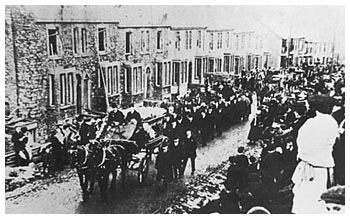 |
FERNDALE COLLIERY DISASTER 10TH JUNE 1869 |
|
| Less than two years after Ferndale suffered its first major colliery explosion this little village in the Rhondda Fach made national headlines once again when another major disaster occurred, this time claiming the lives of 53 miners This time however it was the workers in the Duffryn section of the mine that were killed while those in the Rhondda and Glo-Bach escaped injury, the opposite to what occurred in 1867. The report of the Inspector of Mines was unable to say exactly where the explosion took place and could only surmise as to how it was caused. He believed Ferndale being the only colliery in the immediate vicinity at that time working the areas large quantities of Aberdare steam coal, known as being a ‘fiery coal', became the only outlet for the large quantities of gas trapped within these seams. As such the pit was worked exclusively with locked safety lamps and no shot-firing was allowed during working hours. However the pit suffered from a number of occurrence of falls and sudden influxes of gas into the workings, particularly between the No.6 and No.7 headings where he speculates the explosion could have originated. He believed that one of these sudden influxes of gas passing over a safety lamp, even one in perfect working order, would be enough to cause the subsequent explosion. His theory was that the gases came from the unworked two-feet-nine seam, some ten or twelve yards above the four feet seam where the explosion took place. He thus recommended that this seam be worked in tandem with the four feet seam in future so that the gases contained within it could be dispersed through the mines ventilation system. The conclusion of the inquest criticised the managers of the pit for not implementing all the recommendations made after the 1867 explosion and also criticised the pits ventilation system which they believed did not manage to properly distribute air throughout all the pit. |
|